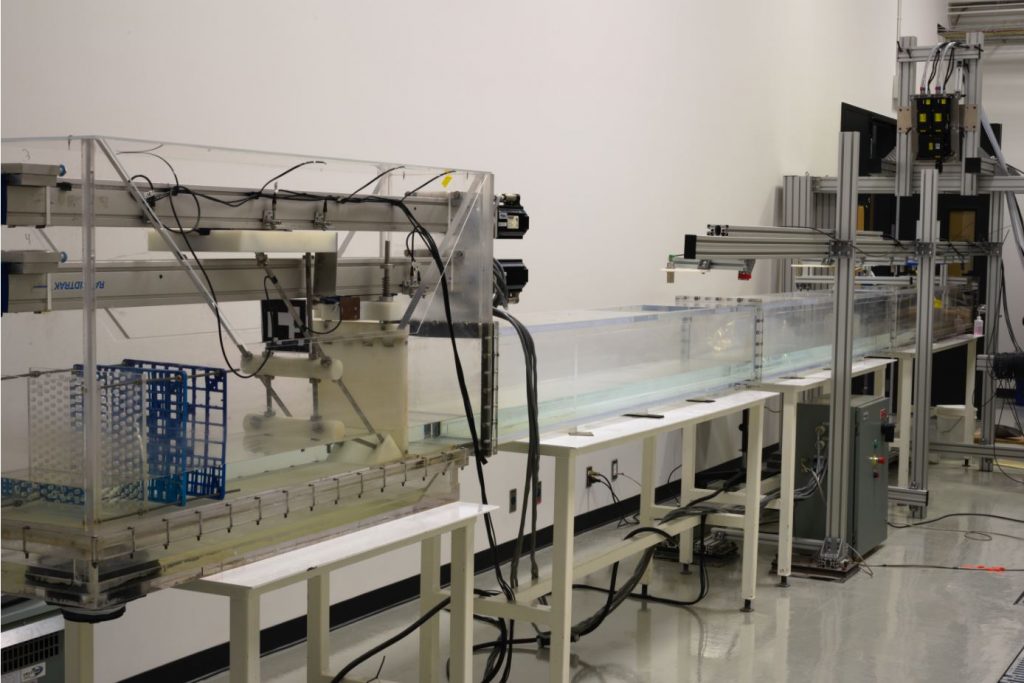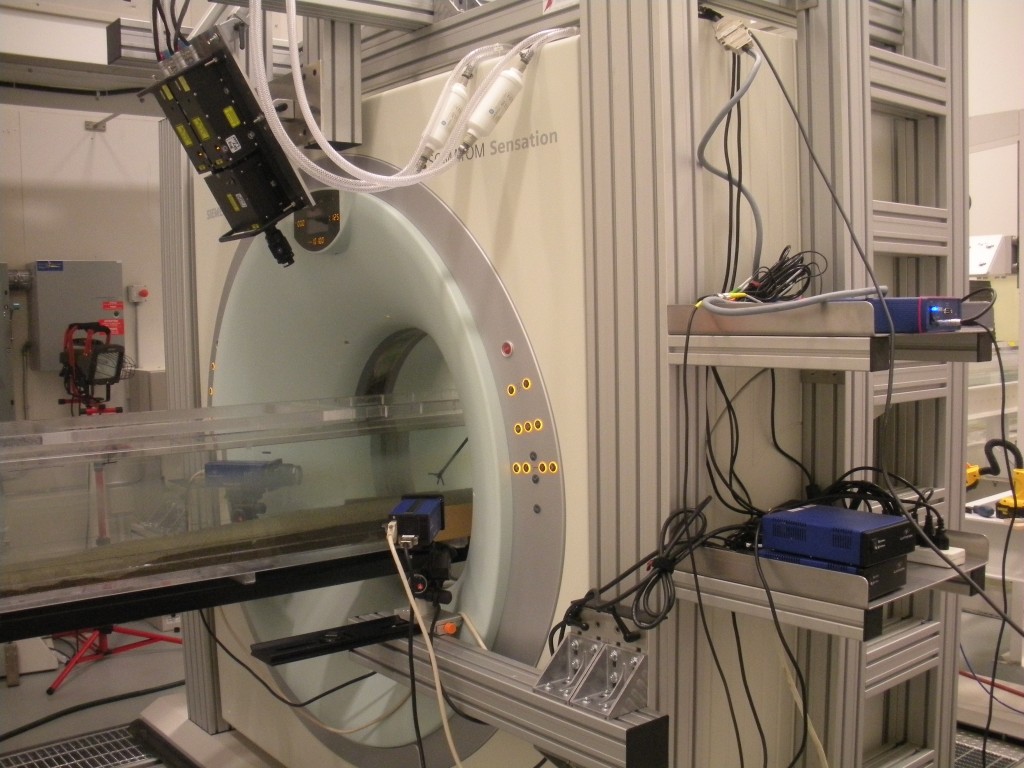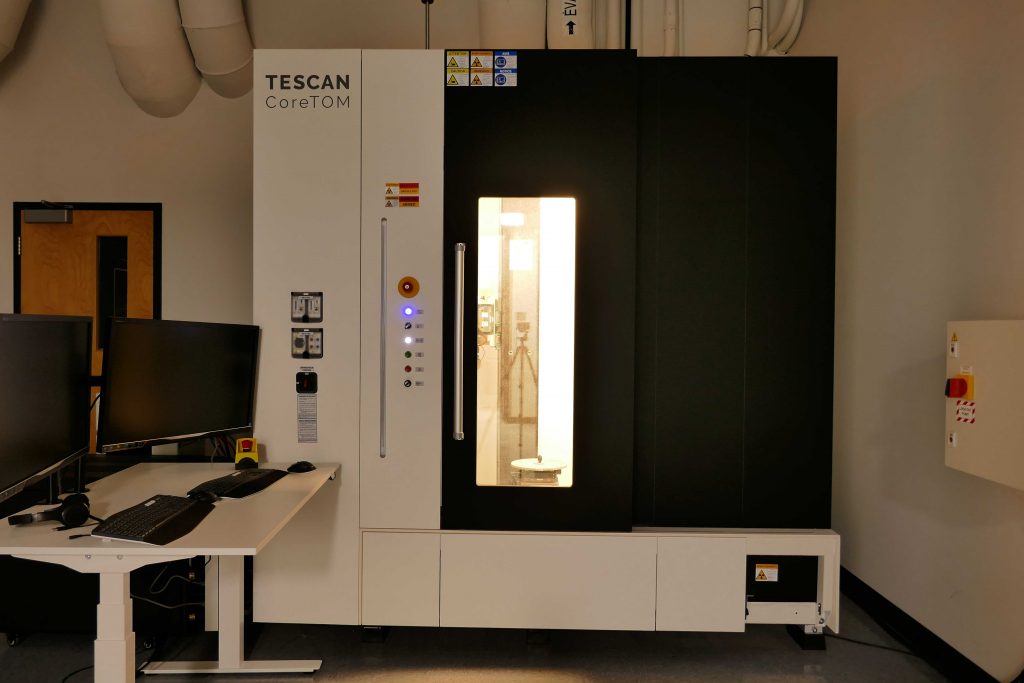The only facility of its kind in Canada, the CT Scanning for Civil Engineering and Natural Resources Laboratory houses cutting-edge equipment capable of non-destructively reconstructing a 3D image of the internal structure and texture of an object at resolutions from 100 microns down to one micron, all in a matter of minutes. The lab also allows for the dynamic study (in 4D) of solid structures and flowing fluids.
Analyses performed in the lab have applications in fields ranging from geology, forestry, and metallurgy to archaeology, paleontology, petrography, and civil engineering, as well as in the study of dynamic phenomena such as fluid flow and shoreline erosion.
The lab is the only facility of its size in Canada and one of just a handful worldwide. It is located in the INRS Laboratories for Scientific and Technological Innovation in Environment complex at the Québec Metro High Tech Park.
CT scanner
The SOMATOM Definition AS+ 128 is mounted on a track system specially designed to ensure accurate placement of the acquisition unit. For very large objects, the track can be extended up to 430 cm. The device is equipped with the latest generation of Siemens Stellar detectors. The maximum image resolution is 97 x 97 x 400 microns/pixels at a slice thickness of 0.4 to 15 mm. The analysis and data storage unit can handle 128 images per second at 512 x 512 voxels. Moreover, the system can function continuously for 80 seconds.Micro CT
The TESCAN CoreTOM is a vertical scanning system using a 45 kg capacity turntable that can accommodate objects up to 1.5 m high by 30 cm in diameter. The maximum resolution for small objects is in the micron range. The system can operate for several hours to reduce the noise level of the images. The samples placed in the micro CT can be connected through baffles and an electronic interface to outside devices such as an environmental chamber, a triaxial or a pressure chamber, all available in the laboratory.HYDÉES instrument room
Dedicated to coastal and fluvial hydraulics, the main study theme of a complementary laboratory, the Environmental Hydraulics Laboratory, which has the largest wave flume in North America. HYDÉES instrument room is equipped with a small wave flume (9 m long, 0.3 x 0.3 m cross-section) and a small current flume (7 m long, 0.3 x 0.3 m cross-section). These small flumes can be placed in the medical CT scanner for dynamic studies. Several measurement instruments are available such as two Lavision PIV systems, one of which is high frequency, acoustic water level sensors, acoustic velocimeters and a medical ultrasound echosounder that can be used as a bathymetric sounder.Sedimentology instrument room
The fully equipped sedimentology lab houses a Beckman Coulter laser-based particle counter and a Beckman Coulter J6.MI.H.C 6 x 1 litre centrifuge, an oven, a high temperature muffle furnace, digital scales, a vacuum filtration system, a vibratory sieve shaker, and a core splitter. An ITRAX Core Scanner allowing non-contact elemental chemical analysis is available at the Geochemistry, Imaging, and Radiography of Sediments Laboratory.GEOTEK instrument room
This space includes a Multi-Sensor Core Logger (MSCL) analysis bench equipped with a line scan camera, a gamma density measurement unit, a magnetic susceptibility sensor, an XRF sensor and a near-infrared spectrometer.- Marine engineering (sediment transport measurement)
- Geological engineering (geological risks and the behaviour of gas hydrates)
- Hydrogeology (migration of fluids and pollutants)
- Forestry (insect pest impacts)
- Dendrochronology (densimetric variations in growth rings)
- Paleontology (identifying microfossils in sediment)
- Marine ecology (behaviour of benthic animals)
- Metallogeny (analysis of the 3D structure of alloys)
- Archeology (analysis of the composition and internal structure of artifacts)
- Materials science (concrete, asphalt, quality control of industrial parts)
- Pedology and the study of permafrost
- Sedimentology and paleoclimatology (sediment core analysis)
- CO2 sequestration (study of the behaviour of rocks and fluids at high pressure)
- Fossilized fish, permafrost core samples, moose teeth, logs… a tremendous variety of objects find their way to the lab
Contacts
Edouard Lauzier
Business development advisor
Phone: 418 654-3728
edouard.lauzier@inrs.ca
Philippe Letellier
Research Officer
Phone: 418-654-2644
philippe.letellier@inrs.ca
Mathieu Des Roches
Research Officer
Phone: 418-654-3798
mathieu.des_roches@inrs.ca
Pierre Francus
Professor
Phone: 418-654-3780
pierre.francus@inrs.ca
CT Scanning for Civil Engineering and Natural Resources Laboratory
Institut national de la recherche scientifique
Laboratory for Scientific and Technological Innovation in Environment
Eau Terre Environnement Research Centre
2605 blvd. du Parc-Technologique
Québec City, Quebec G1P 4S5
Canada






